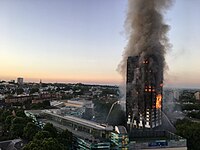
Photo from wikipedia
A majority of fatal fires occur in housing. An understanding of risk factors and risk groups is necessary for well-founded decisions regarding targeted prevention efforts. This study aimed to investigate… Click to show full abstract
A majority of fatal fires occur in housing. An understanding of risk factors and risk groups is necessary for well-founded decisions regarding targeted prevention efforts. This study aimed to investigate the association between sociodemographic factors and residential fire fatalities in Sweden. Data on the fatalities were obtained from a compiled database using linked data from the database on fatal fires, the database on forensic examinations, and the Cause of Death Register. Four controls per fire victim were matched on age and sex from the Swedish population register. Data on sociodemographic variables were linked to both cases and controls by Statistics Sweden. Adjusted odds ratios (ORs) with 95% confidence intervals (CI) were calculated using multivariate conditional logistic regression. The results show clearly that low socioeconomic status is associated with high risk. The most important factors which increase the risk of death are having a low disposable income, receiving social allowance and receiving health-related early retirement pension. Factors which decrease risk are living with a partner, being in employment and being highly educated. However, regarding disability allowance and housing tenure no association could be observed. The findings in this study show that sociodemographic factors play a role in the etiology of residential fire fatalities. Knowledge that can be used to recognize high-risk households in Sweden, which need preventative interventions such as home safety education and home visitation programmes.
Journal Title: Injury Prevention
Year Published: 2018
Link to full text (if available)
Share on Social Media: Sign Up to like & get
recommendations!